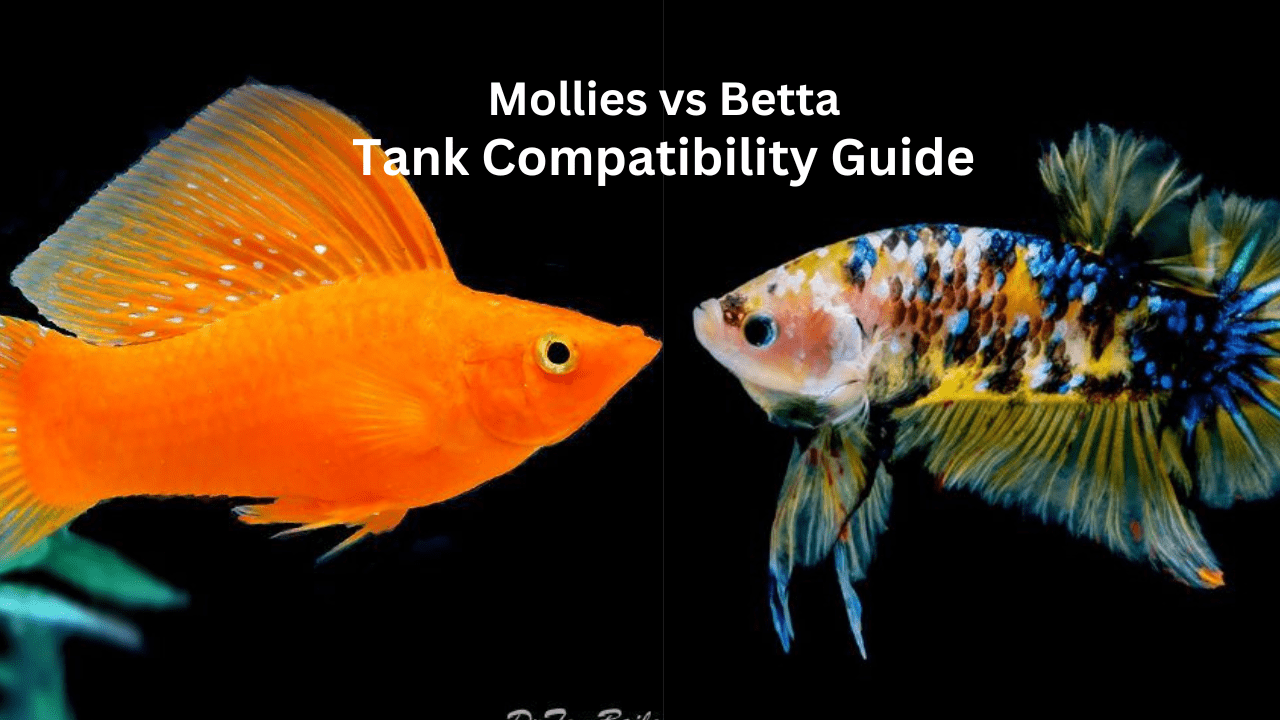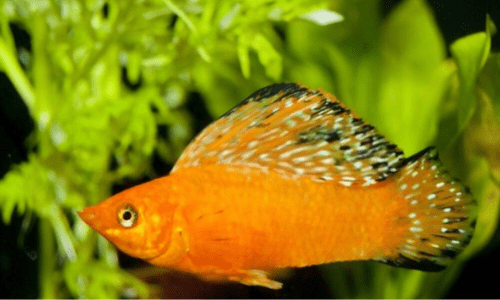Hey aquarists! Wondering if Betta fish and Mollies can share a tank? Let’s dive into this expert guide.
While it’s possible for Bettas and Mollies to live together, it’s not always smooth sailing. They can coexist, but only under the right conditions. Stick around as we explore the essential tips and tricks to make it work!

Understanding Mollies
Let’s go through the general introduction of mollies.
Species Summary
Mollies are a diverse group within the Poecilia family, closely related to guppies, and are known for their active nature and social behavior. These freshwater fish are admired for their live-bearing capabilities and their wide variety of colors and forms.
Molly Varieties
Some of the most common types include:
Black Molly: Recognized for its solid black coloration, the Black Molly is a peaceful fish that thrives in a variety of tank conditions. As livebearers, Black Mollies are easy to breed and adapt well to a range of water conditions, making them a versatile addition to any community tank. With their elegant black sheen, Black Mollies make a stunning contrast in aquariums, especially when paired with brightly colored tankmates.

Dalmatian Molly: With a white body speckled with black spots, the Dalmatian Molly brings a playful pattern and dynamic energy to any aquarium. With their playful personality and easy care requirements, Dalmatian Mollies make a fantastic addition to both community tanks and beginner aquariums. Dalmatian Mollies are livebearers, and their unique coloration adds a beautiful contrast to any aquarium, thriving in a variety of water conditions. Whether you’re a beginner or an experienced aquarist, Dalmatian Mollies are low-maintenance and adaptable, offering both beauty and ease in aquarium care.

Sailfin Molly: Notable for its large, sail-like dorsal fin displayed by males, the Sailfin Molly comes in various colors and is especially striking during mating displays. Sailfin Mollies are hardy and adaptable, thriving in a variety of water conditions, which makes them perfect for both beginners and seasoned aquarium hobbyists. With their peaceful nature and stunning fins, Sailfin Mollies are an excellent choice for community tanks, where they can peacefully coexist with other species. Sailfin Mollies are livebearers that breed easily, and their graceful movements and unique fin structure add a touch of elegance to your aquarium.

Natural Habitat
Native to the Americas, from the southern United States to Colombia, mollies inhabit freshwater, brackish waters, and even slightly salty estuaries. Found in streams and coastal regions, their ability to adapt to diverse water conditions makes them a perfect fit for aquarium enthusiasts seeking versatile and hardy fish.
Understanding their natural habitat is essential for providing optimal care in captivity. In the wild, mollies thrive in warm waters with abundant vegetation, which supports their health and behavior.
- Warm Temperatures: Maintain a stable range of 25°C to 28°C (77°F to 82°F).
- Planted Environments: Aquatic plants offer shelter, breeding grounds, and improved water quality by providing oxygen and absorbing nutrients.
- Slightly Alkaline Water: A pH level between 7.5 and 8.2 replicates their natural conditions, promoting health and vitality.
Creating these conditions ensures a thriving environment for mollies in an aquarium.
Are Betta Fish and Mollies Compatible Tank Mates?
Yes, Betta fish and Mollies can live together with proper tank setup, monitoring, and care. Their coexistence depends on individual temperaments and environmental conditions.
Here’s a friendly, step-by-step guide to help you set the stage for a peaceful tank.
Key Considerations for Housing Bettas and Mollies Together
The following key factors must be considered to successfully keep Betta fish and Mollies together in the same tank.
1.Tank Size
A 20-gallon tank is the minimum size recommended for housing bettas and mollies together. Mollies are highly active swimmers and need ample space to move freely.
At the same time, bettas require room to establish their territory and avoid conflicts. Providing a spacious aquarium helps maintain a peaceful and stress-free environment for both species.
2.Temperament
Mollies are typically peaceful fish, but they may display fin-nipping behavior under certain conditions.Overcrowded tanks or high levels of stress can trigger this behavior, potentially causing harm to tank mates like bettas. Ensuring a spacious and well-maintained aquarium can help reduce this risk and promote harmony.
3.Water parameters
Water parameters are crucial when keeping bettas and mollies together. Both species thrive in warm water between 75–80°F, but their pH preferences differ. Mollies prefer slightly alkaline water (pH 7.5–8.5), while bettas favor neutral to slightly acidic water. Striking the right balance in water conditions is essential for their health and compatibility.
4.Feeding Requirements
Dietary needs vary between mollies and bettas, as mollies are omnivores and bettas are carnivores. Mollies require a mix of plant-based foods and proteins, while bettas thrive on a high-protein diet like insects and brine shrimp. Providing a balanced diet with enough variety ensures both species meet their nutritional requirements and remain healthy.
5.Behavior Monitoring
Monitoring behavior is essential when keeping bettas and mollies together. Watch closely for signs of aggression, such as chasing, nipping, or flared fins, which indicate conflict. If these behaviors persist, promptly separate them into different tanks to ensure the safety and well-being of both species.
How to Introduce Bettas and Mollies to the Same Tank
Here’s a friendly, step-by-step guide to help you set the stage for a peaceful tank.So, you’re ready to bring Betta fish and Mollies together in one tank? That’s exciting! But before you jump in, let’s talk about how to make the transition smooth and stress-free for your fishy friends.
1.Start with the Right Tank Setup
The foundation of a harmonious tank starts with size. Bettas and Mollies need room to swim and explore without stepping on each other’s fins. Go for a tank that’s at least 20 gallons.
Add plenty of plants, rocks, and decorations to create hiding spots. These little hideaways help reduce stress and give each fish their own corner of the tank to retreat to. A happy fish is a peaceful fish!
Don’t forget the water! Both Bettas and Mollies love warm water (75-80°F) with a pH between 7.0 and 7.8. A good filter and regular water changes will keep everything fresh and healthy.
2.Quarantine Is Key
Before introducing your fish, give any newcomers a two-week quarantine. It’s like a little health check-up to make sure they’re not bringing any unwanted diseases or parasites into your tank. Prevention is always better than a tank full of stressed or sick fish.
3.Add Mollies First
Here’s a pro tip: let the Mollies move in before the Betta. Mollies are easy-going and will settle in quickly, helping to establish a calm vibe in the tank. Once the Betta joins, it’ll feel less like “its territory” and more like a shared space.
4.Ease into It with a Tank Divider
Worried about how your Betta will react? Use a tank divider for the first few days. This way, the fish can see each other and get used to their new neighbors without any physical confrontations. It’s like a “getting-to-know-you” period for fish!
5.Keep a Close Eye on Behavior
Once you remove the divider, watch closely. Bettas can be territorial, and Mollies love to explore. Look for signs of aggression like chasing, nipping, or flaring. If you see tension, try rearranging the tank decorations to disrupt territorial claims. In worst-case scenarios, you might need to separate them.
6.Feed Them Right
Food fights can ruin any tank friendship! Make sure both Bettas and Mollies get the right diet. Bettas thrive on protein-rich foods, while Mollies prefer a mix of protein and veggies. Feed them at the same time but in different spots to reduce competition.
7.Stay Patient and Adjust as Needed
Introducing two species is a process. It might take some time for your Betta and Mollies to find their groove. Keep an eye on their interactions, and don’t hesitate to make changes if needed. Adding more plants or rearranging the tank can work wonders if tensions rise.
8.Be Ready to Step In
If things don’t work out despite your efforts, don’t feel bad! Some Bettas just don’t like sharing their space, no matter how perfect the setup. Be prepared with a backup plan, like a separate tank, just in case.
Advanced Care Tips for Mollies
To ensure your Mollies live longer and healthier lives, follow these advanced care techniques:
- Optimal Water Quality: Keep water conditions pristine by regularly testing and adjusting parameters. Perform weekly water changes of 25-30% to reduce stress and prevent disease.
- Dietary Excellence: Offer a varied diet, including high-quality flakes or pellets, supplemented with live or frozen foods like bloodworms or brine shrimp. Add vegetables like blanched spinach or zucchini for extra nutrition.
- Stress Reduction: Minimize stress by avoiding overcrowding, providing ample hiding spots, and maintaining a peaceful environment with compatible tank mates.
- Regular Health Checks: Inspect your Mollies frequently for signs of illness or stress. Early detection and treatment of issues are vital to extending their lifespan.
These steps will help keep your Mollies thriving and happy in your aquarium.
Benefits of Keeping Betta Fish and Mollies in One Tank
Housing Betta fish and Mollies together can create a stunning and lively aquatic environment. While compatibility requires careful consideration, the benefits of successfully keeping them in one tank are worth the effort. Here are the top advantages:
1.A Vibrant and Colorful Display
Betta fish are known for their striking fins and bold colors, while Mollies bring a variety of shades and patterns to the tank. Together, they create a visually stunning display that makes your aquarium a true centerpiece.
2.Increased Activity and Interaction
Mollies are active swimmers that love to explore, adding movement and life to the tank. Their energetic behavior complements the graceful swimming style of Bettas, creating a dynamic and engaging environment.
3.Balanced Tank Ecosystem
Mollies are excellent at cleaning up algae, which helps maintain a cleaner tank. Combined with Bettas’ preference for eating leftover food, they contribute to a balanced and well-maintained aquatic ecosystem.
4.Learning and Observation Opportunities
Keeping Bettas and Mollies together offers a chance to observe the unique behaviors and interactions between two different species. It’s a fascinating experience for fish enthusiasts, providing insights into their personalities and social dynamics.
5.A Peaceful Community (When Done Right)
When housed in a properly prepared tank with adequate space and hiding spots, Bettas and Mollies can coexist peacefully. Watching them thrive together is rewarding and showcases your success as a skilled aquarist.
Curious to know about snail compatibility with betta? Then read : Can Snails Live with Bettas?
FAQs
Can 1 Molly fish live alone?
Mollies aren’t schooling fish, meaning they don’t move in perfect synchronization, but they do exhibit shoaling behavior, swimming together loosely. They thrive in groups and feel more secure with other mollies or peaceful shoaling fish. Keeping them alone can lead to stress and fearfulness, so experts recommend housing at least five mollies together to ensure their well-being.
What kills molly fish?
Mollies thrive in hard water with plenty of minerals. If you have naturally hard tap water, your mollies are likely to do well. However, in soft water lacking essential minerals, they may become prone to diseases such as ich (white spot disease), fungus, and livebearer disease. To keep your mollies healthy, ensure the water has adequate mineral content or consider using supplements if necessary.
Are mollies hard to keep alive?
Mollies are peaceful livebearers that give birth to live young and reproduce quickly. They thrive in groups and are available in a stunning variety of colors, patterns, and fin lengths. Highly adaptable to water changes, mollies are an excellent choice for beginner aquarists, offering beauty and ease of care.
Conclusion
Bettas and Mollies can live together, but they’re like roommates who need their space and certain conditions to get along. With effort, you can create a vibrant aquarium that’s both rewarding and visually stunning. Prioritize their health and happiness for success!
